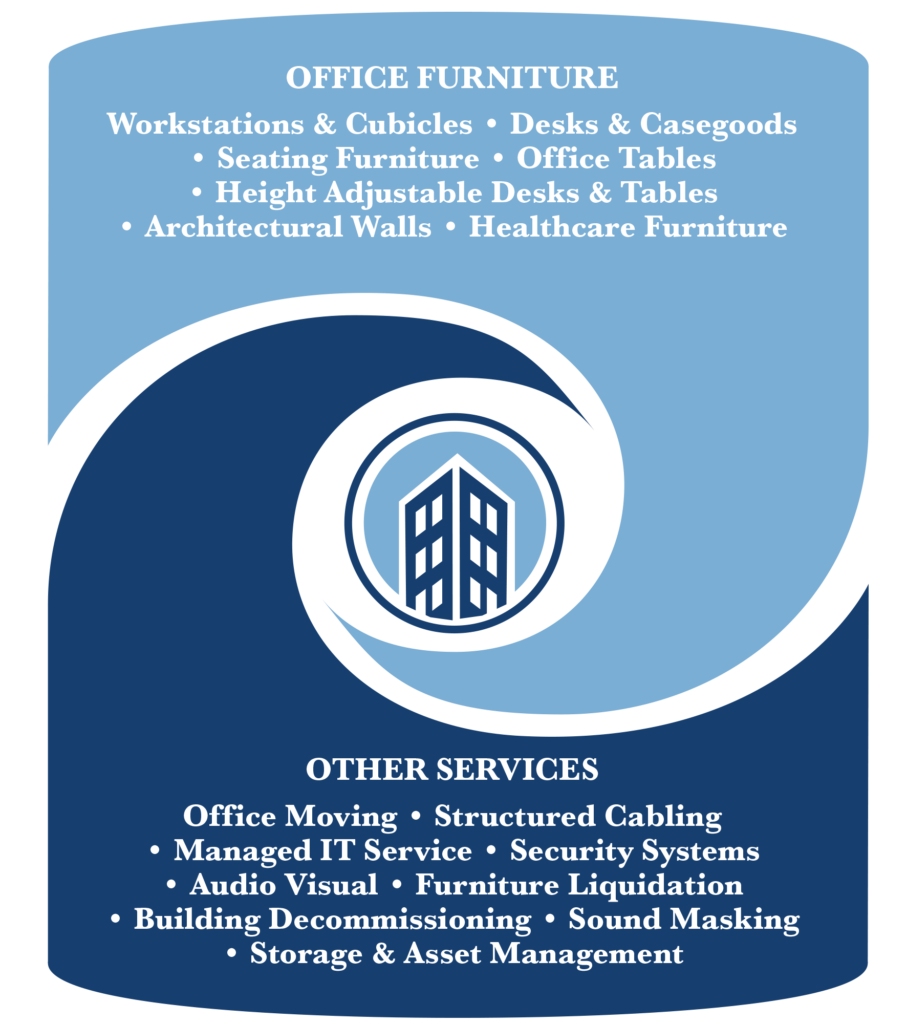18 Oct The Importance of Proper Desk Ergonomics
In today’s fast-paced world, many individuals spend a surprising amount of time sitting at their desks. Because of that fact, adopting proper desk ergonomics has become paramount. Ergonomics, the study of optimizing the work environment to minimize physical strain and discomfort, plays a crucial role in promoting overall well-being and productivity. By understanding and implementing proper ergonomic principles, you can create a workstation that not only enhances your comfort but also supports your long-term health and performance.
Neglecting proper ergonomics can have severe consequences, such as musculoskeletal disorders, chronic pain, and decreased productivity. Poor posture, repetitive movements, and inadequate support can lead to conditions like carpal tunnel syndrome, neck and back pain, and eye strain. These issues can significantly impact the quality of life and work performance of you and your employees. It is essential to prioritize ergonomic considerations in your workspace.
By investing time and effort into creating ergonomically sound workstations, you not only safeguard your physical well-being but also foster a more productive and enjoyable work environment. Proper desk ergonomics can reduce fatigue, improve focus, and enhance overall job satisfaction. This focus contributes to professional success and personal fulfillment for your entire team.

Understanding the risks of poor ergonomics
 Failing to prioritize ergonomics in your workspace can have detrimental effects on your physical and mental well-being. Poor ergonomics can contribute to a range of issues, including:
Failing to prioritize ergonomics in your workspace can have detrimental effects on your physical and mental well-being. Poor ergonomics can contribute to a range of issues, including:
- Musculoskeletal Disorders (MSDs): Improper posture, repetitive movements, and prolonged static positions can lead to conditions such as carpal tunnel syndrome, tendonitis, and lower back pain. These disorders can cause significant discomfort and impair your ability to perform daily tasks.
- Neck and Back Pain: Caused by sitting for extended periods with poor spinal alignment or inadequate lumbar support. This strains the muscles and joints in your neck and back, leading to chronic pain and discomfort.
- Eye Strain and Headaches: Improper monitor positioning, glare, or poor lighting can cause eye fatigue, headaches, and vision problems. These issues negatively impact your productivity and overall well-being.
- Reduced Productivity: Discomfort, pain, and fatigue resulting from poor ergonomics can hinder your ability to concentrate and perform at your best.
- Increased Absenteeism and Healthcare Costs: Ergonomic-related injuries and illnesses can lead to missed workdays, increased medical expenses, and lost productivity.
By understanding these risks, you can appreciate the importance of prioritizing proper desk ergonomics. Taking proactive steps to create a healthier and more productive work environment is good business.
Key components of a well-designed workstation
To achieve optimal ergonomics at your desk, it is essential to consider the following key components and ensure proper configuration:
- Desk Height: Your desk should be adjusted to a height that allows your forearms to rest comfortably on the surface while your elbows form a 90-degree angle. This positioning helps reduce strain on your shoulders and neck.
- Chair: Invest in an ergonomic chair that provides proper lumbar support, adjustable seat height, and armrests. A well-designed chair can help maintain good posture and alleviate pressure on your lower back.
- Monitor Positioning: Position your monitor at eye level and an arm’s length away to prevent neck strain and eye fatigue. Adjust the tilt and brightness to minimize glare and reduce eye strain.
- Keyboard and Mouse: Keep your keyboard and mouse within comfortable reach, allowing your arms to rest naturally by your sides. Consider using an ergonomic keyboard and mouse to reduce strain on your wrists and hands.
- Lighting: Ensure adequate lighting in your workspace to reduce eye strain and glare. Adjust blinds or curtains to control natural light and use task lighting if necessary.
- Footrest: If your feet do not rest comfortably on the floor when seated, use a footrest to promote proper posture and alleviate pressure on your thighs and legs.
- Document Holder: Position document holders at the same level and distance as your monitor to minimize neck strain caused by constantly shifting your gaze between documents and the screen.
By addressing these key components and tailoring your workstation to your specific needs, you can create an ergonomically sound environment that supports your comfort, health, and productivity.
Setting up your desk for optimal ergonomics
 Achieving proper desk ergonomics requires careful consideration and adjustment of your workstation. Follow these steps to optimize your desk setup:
Achieving proper desk ergonomics requires careful consideration and adjustment of your workstation. Follow these steps to optimize your desk setup:
- Evaluate Your Workspace: Start by assessing your current workspace, identifying areas that may be causing discomfort or strain. Take note of the desk height, chair positioning, monitor placement, and overall layout. Consider adjustable height workstation solutions to create greater flexibility.
- Adjust Your Chair: Ensure your chair is at the correct height, allowing your feet to rest flat on the floor or a footrest. Adjust the backrest to provide ample lumbar support and maintain a slight recline angle.
- Position Your Monitor: Place your monitor directly in front of you, at eye level, and an arm’s length away. Adjust the tilt and brightness to minimize glare and eye strain.
- Organize Your Desk: Keep frequently used items within easy reach to minimize excessive stretching or twisting. Organize your desk to create a clutter-free environment, reducing visual distractions and promoting better focus.
- Incorporate Ergonomic Accessories: Consider investing in ergonomic accessories such as a keyboard tray, wrist rest, or footrest to further enhance your comfort and support proper posture.
- Take Breaks and Stretch: Remember to take regular breaks and incorporate stretching exercises into your routine. This can help alleviate muscle tension and prevent fatigue caused by prolonged static postures.
- Seek Professional Assistance: If you experience persistent discomfort or have specific ergonomic concerns, consider consulting with a professional ergonomist or occupational therapist for personalized guidance and recommendations.
By following these steps and adjusting as needed, you can create a workstation that supports your body’s natural alignment, reduces strain, and promotes overall comfort and productivity.
Adjusting your computer monitor and keyboard for ideal positioning
Proper positioning of your computer monitor and keyboard is crucial for maintaining good posture and minimizing strain on your eyes, neck, and upper body. Follow these guidelines to ensure optimal ergonomics:
Monitor Positioning
- Eye Level: Position the top of your monitor at or slightly below eye level to prevent neck strain from looking up or down for extended periods.
- Distance: Place your monitor an arm’s length away, approximately 20-26 inches from your eyes, to reduce eye strain and maintain a comfortable viewing distance.
- Tilt and Swivel: Adjust the tilt and swivel of your monitor to minimize glare and reflections, ensuring a comfortable viewing angle without straining your neck.
- Dual Monitors: If using dual monitors, position them side by side and at the same height to minimize neck twisting and excessive eye movement.
Keyboard Positioning
- Keyboard Tray: Consider using an adjustable keyboard tray to keep your keyboard at the proper height, allowing your forearms to rest comfortably on the desk surface. Even if your workstation does not come with a keyboard tray, we can identify solutions to augment your workspace.
- Wrist Rest: Incorporate a wrist rest to support your wrists and reduce strain when typing, preventing conditions like carpal tunnel syndrome.
- Keyboard Angle: Adjust the keyboard angle to maintain a neutral wrist position, minimizing excessive bending or extension. All quality keyboards offer variable angle adjustments.
- Mouse Positioning: Position your mouse close to your keyboard to avoid excessive reaching or twisting of the arm and shoulder.
By following these guidelines and adjusting as needed, you can create an ergonomically sound workstation that supports proper posture, reduces eye strain, and minimizes the risk of musculoskeletal disorders.
The benefits of investing in ergonomic furniture and equipment
 While setting up your workstation with proper ergonomics in mind is essential, investing in ergonomic furniture and equipment can further enhance your comfort, health, and productivity. Here are some of the key benefits of incorporating ergonomic solutions into your workspace:
While setting up your workstation with proper ergonomics in mind is essential, investing in ergonomic furniture and equipment can further enhance your comfort, health, and productivity. Here are some of the key benefits of incorporating ergonomic solutions into your workspace:
- Reduced Risk of Injuries and Musculoskeletal Disorders: Ergonomic furniture and equipment are designed to support proper posture, minimize strain, and reduce the risk of developing physical problems.
- Improved Comfort and Productivity: By providing appropriate support and reducing physical discomfort, ergonomic solutions can help you maintain focus and concentration for longer periods, leading to increased productivity and job satisfaction.
- Customizable and Adjustable: Many ergonomic products offer adjustable features, allowing for tailored individual settings. Specific body dimensions and preferences are considered, ensuring a personalized and comfortable fit.
- Long-Term Cost Savings: While ergonomic furniture and equipment may require an initial investment, the long-term benefits of reduced healthcare costs, increased productivity, and decreased absenteeism can lead to significant cost savings for both individuals and organizations.
- Enhanced Well-being and Quality of Life: By prioritizing ergonomics and investing in supportive equipment, you can experience improved physical and mental well-being.
Some popular ergonomic solutions to consider include adjustable standing desks, ergonomic chairs with lumbar support, keyboard trays, monitor arms, and ergonomic mouse and keyboard designs. MyOffice has the experience and manufacturer connections to select the best options. Reputable brands and products undergo rigorous testing and meet industry standards for ergonomic design. This is important to ensure long-term utility and usefulness.
Resources and tools for further learning and support
 Mastering proper desk ergonomics is an ongoing process that may require additional resources and support. Here are some helpful tools and resources to further enhance your ergonomic knowledge and implementation:
Mastering proper desk ergonomics is an ongoing process that may require additional resources and support. Here are some helpful tools and resources to further enhance your ergonomic knowledge and implementation:
- Online Ergonomic Assessments: Many reputable organizations and ergonomic product manufacturers offer online self-assessment tools to evaluate your workstation setup and provide personalized recommendations.
- Ergonomic Checklists and Guides: Consult ergonomic checklists and guides provided by organizations like OSHA, NIOSH, or professional ergonomics associations to ensure you are covering all aspects of a well-designed workstation.
- Ergonomic Consultants and Professionals: Consider consulting with ergonomic experts, occupational therapists, or certified professional ergonomists for personalized assessments, recommendations, and guidance on optimizing your workstation.
- Ergonomic Training and Workshops: Attend ergonomic training sessions or workshops offered by your employer, professional organizations, or local educational institutions to learn best practices and stay up-to-date with the latest ergonomic trends and research.
- Online Resources and Communities: Explore online forums, blogs, and social media groups dedicated to ergonomics, where you can connect with others, share experiences, and gain insights from experts in the field.
- Ergonomic Product Reviews and Comparisons: Research and read reviews of ergonomic furniture and equipment to make informed purchasing decisions and ensure you invest in high-quality, effective solutions.
By leveraging these resources and seeking ongoing education and support, you can continually refine and improve your ergonomic practices, ensuring a healthy and productive workstation that adapts to your changing needs over time.
Conclusion: Prioritizing proper desk ergonomics for a healthier and more productive workspace
Proper desk ergonomics is not just a luxury; it’s a necessity for maintaining good health, well-being, and productivity. Contrary to the wishes of most, we still function in sedentary work environments. By understanding the importance of ergonomics and implementing the principles discussed in this article, you can create a proper desk ergonomics office environment.
Prioritize the wellbeing of your team by contacting MyOffice to discuss solutions. Do not let poor ergonomics hold you or your team back – take the first step towards a healthier and more productive workspace today. Contact us now to schedule your assessment and unlock the full potential of proper desk ergonomics.
(Images Sourced from Pexels, Unsplash and Global Furniture Group)
Ready to take the first step towards making your office a shining example of proper desk ergonomics for your employees? Contact our team of office furniture experts today to learn more about our comprehensive services and how we can help you navigate the concerns over ergonomics.
MyOffice has over 20 years of experience in supporting client’s implementing office solutions. We understand the needs of the modern office environment. Optimizing your workspace through furniture selection and layout is a core competency of ours. We are here to help!

